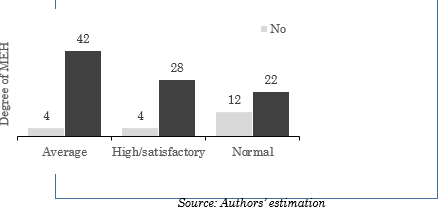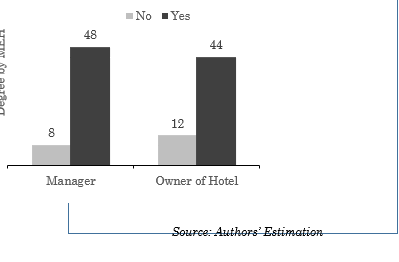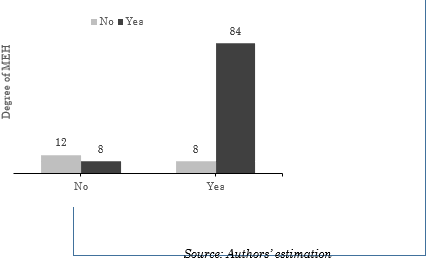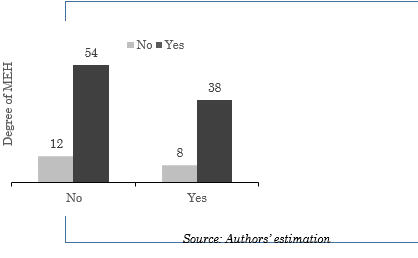Abstract:
This research work explores the influence of the CPEC on hotel industry progress in the Hazara region. Using a purposive simple random sample approach, the primary data was collected through questionnaire from 112 hotel managers/owners by addressing their responses to aspects related to the future hotel industry growth forecasts in the Hazara region under the CPEC. The technique used for the analysis of the study is logistic regression. The results show that hotel facility score, manager's awareness of CPEC, investment opportunities in hoteling industry under CPEC, the impact of the project seen in the region after initiating of project, and increase of tourist due to E-35 CPEC motorway are contributing to the growth of hoteling industry under the CPEC. The study concludes that it is expected that in the future, demand for tourism will increase, so there is a need to enhance the infrastructure and standards of hotels on the international level.
Key Words:
Binary Logistic Model, CPEC, Hotel Industry Growth, Hazara Region
Introduction
The focus of this research is to find out the that whether under the China-Pakistan Economic Corridor (CPEC), the construction of the Hazara motorway that spreads along Pakistan's northern areas will significantly contribute or not to the growth of the hotel industry in the Hazara region? Forbes (2018), one of the most widely circulated business magazines in the United States, ranked Pakistan as one of the top ten countries to visit in 2019 through the famous Karakorum motorway, which is expected to enhance tourism in Pakistan (Ann Abel, 2019). In 2018, the British Backpacker Society, one of the world's premier tourism advisory groups, graded Pakistan as the highest-rated country among twenty countries visited by backpackers (Sana Jamal, 2017).Due to the increase in tourism which has become an important part of the economy now, there is a demand to improve and construct hotels in the tourist visited places in Pakistan. The hotel sector in any tourism country also considered a backbone for tourism because hotels promotes the food culture and tourism of that country.
Quality of services are highly correlated with hotel industry growth and considered the lifeblood for the hotel sector (Min, 1997). According to Gundersen et. at., (1996) service quality leads to higher profitability. In Pakistan, the hotel industry contributes 3 percent to GDP (Javed and Hussain, 2018). From 2012-2014 the share of restaurants in the total employment is 1.31 percent (Labor Force Survey 2010-11). In Pakistan, the average household spends 1.14 percent of its overall food budget on hotels and restaurants (Household Integrated Economic Survey 2010-11).
Hoteling provide a safe and pleasant environment for tourist, which is a necessary requirement for tourism. Pakistan has already opened the Kartarpur corridor for religious tourism while visiting country and mountains tourism always remained on peek. But unfortunately, the hoteling sector could not have been improved on an international level because over the past two decades as Pakistan faced war and terroir. Due to the expansion of tourism, the hotel business requires development since it generates both direct and indirect job opportunities (Abbasi et. al., 2010). Pakistan has long been a tourist attraction due to its natural beauty. Hotels not only provide lodging for international visitors, but they also have a positive impact on the national budget (Abbasi et. al., 2010). Now, the future of the hotel industry in Pakistan is to expand and build hotels and services according to the need of both national and international tourists as Pakistan is going to be the world's top best destination in the world for tourism.
There has been so much talk during the past few years on CPEC as a game-changer for Pakistan after initiating the CPEC project. CPEC will provide Pakistan with economic opportunities and may increase regional and cross-regional commercial and economic inclusion between South Asia, Central Asia, East Asia, and West Asia (Hussain et al., 2016). The CPEC will also increase tourism service quality, which will have a long-term influence on socio-economic growth. The development of the E-35 Hazara motorway that extends along the northern areas of Pakistan is to enhance trade, connect two countries to Gwadar port, and, more importantly, enhance tourism. The E-35 Hazara motorway, which is a part of the CPEC road network, will give a new gateway to South Asia, Central Asia, East Asia, and West Asia, as well as a faster and safer mode of road communication for tourists. The goal of this study is to see how the China-Pakistan Economic Corridor affects the hotel business in the Hazara region.
Methodology and Model Specifications
The Hazara region is discussed in this study, which covers two districts: Abbottabad and Mansehra. These districts have been identified as the most frequently visited tourist destinations by the Tourism Corporation of Khyber Pakhtunkhwa (TCKP) and the Galiyat Development Authority (GDA), and the CPEC is also passing through this region.
Sample Distribution and Data Collection
This study relied on primary data, which was gathered using a structured questionnaire. Purposive simple random sampling was used to collect responses from hotel managers/owners about their expectations for hotel industry growth under CPEC. A total of 112 hotel managers and owners were allocated from the three most popular tourist destinations in both districts, with 57 from Abbottabad and 57 from Mansehra. For one hotel, one response from the manager/owner was considered. As a result, answers from 112 hotels were collected for this study. From July to August 2018, data was collected in the research region for two months. During the pre-interview meeting, hotel managers/owners gave their verbal consent. All the 112 hotel managers/owners agreed to voluntarily participate in the study.
Table 1. Allocation of District Sample to Further most Hotel and Visited Sport Areas
|
Abbottabad District |
Mansehra District |
|
Further
allocation: |
|
|
Nathia Gali= 19 respondents |
Naran
Kaghan = 19 respondents |
|
Ayubia= 19 respondents |
Balakot
= 19 respondents |
|
Abbottabad city = 19 respondents |
Mansehra = 19
respondents |
|
Total = 57
respondents |
Total = 57 respondents |
Source: Authors
Model Specification
The dependent variable in this study is MEH (Manager Expectation for Hoteling Industry Growth under CPEC), which is in binary form. The model of the econometric equation is as under:
MEHij= ?0 + ?1Edu_Mij+?2CWSij+?3AOCij+?4IOHIUCij+ ?5IMOPij+ ?6IOTij+ ?7CIUCij+ ?8HFSij+?ij ------------- (1)
1= if the manager expects that under CPEC Hoteling industry will grow (response is "Yes").
0= Otherwise (if the response is “No”)
The coefficients (?'s) in the equation-1 describes the degree of relationship with the dependent variable, MEH, while ? is the error term. The definition and the explanation of all variables employed in the model is given as follow in Table 2
Table 2. Variables’ Operational Definitions in the Econometric Model
|
|
Name
of Variable |
Operational
Definitions |
|
|
Dependent
Variables: |
|
|
|
Manager's Expectation for the
hoteling industry's |
1
if yes, 0 if no |
|
|
growth under CPEC (MEH) |
|
|
|
Explanatory
Variables: |
|
|
|
Education
of manager |
1
for basic education, 0 for higher education |
|
|
Current
working status of the respondent |
1 if the owner, 0 if the manager |
|
|
Hotel
facility score |
1
for normal, 2 for average, 3 for high/satisfactory |
|
|
Awareness of CPEC |
1for
aware, 0 for not aware |
|
|
Investment opportunities in hoteling
industry |
1if yes, 0 no |
|
|
Increase under CPEC |
|
|
|
After
initiating of CPEC project in this region |
1 high impact (yes), 0 if no low
impact (no) |
|
|
any impact seen on the hotel industry |
|
|
|
Tourist will come more due to E-35 |
1 if yes, 0 if no |
|
|
motorway |
|
|
|
Customer (local and international)
increases |
|
|
|
under CPEC |
1 if the increase (yes), 0 if not
increase |

Construction of Hotel Facility Score/Index (HFS)
In the research, Hotel Facility Index is constructed based on six questions regarding facilities and services in the hotel. The index is in binary form. If the reply of the manager to the question for specific hotel services is "Yes," it assigned=1, otherwise 0 if the reply is no. Further, this index is categorized into three groups; normal, average and High/satisfactory. Facilities in hotels value range for normal HFS group from 0 to 3 and for average HFS group from 4 to 5 and further for high/satisfactory HFS group range of value is 6 to 9. The total range is 0 to 9. HFS high/satisfactory shows that the hotel has maximum facilities. The facilities that asked from manger are includes: 1-Restaurant services; 2- Room services; 3- credit card; 4- Conference Hall; 5- Medical facilities; 6- outdoor sports; 7- Telephone; 8- safety locker; and 9-Foreign Exchange.
Analysis Methodology
The Cross-tabulations was for the bivariate analysis while logistic regression was employed for multivariate analysis.
Results and Discussion
The research work focuses on both descriptive analysis for presenting the inter-relationship and the econometric analysis between the dependent and independent variables. The following Table-3 describes the frequency and percentages of the hotel manager/owner’s expectations rate according to different characteristics in whom the managers responded that the CPEC project has an impact on hotel industry growth.
Furthermore, the econometric model estimated the outcome of several influencing factors on the manager's expectation for the hoteling industry's growth under the China-Pakistan Economic Corridor which is presented in Table-4.
Descriptive Statistics Table 3. Estimation of Hotel Manager Expectation Regarding Hotel Industry Growth under CPEC by Percentage of each Variable
|
Manager’s
Expectation Regarding Hotel Industry Growth Under CPEC (MEH) |
Frequency
MEH in Hotel Managers who responded (Yes) |
Percentage
MEH in Hotel Managers (%) |
|
Education of Manager |
||
|
Basic Education |
40 |
35.71 |
|
Higher Education |
52 |
53.57 |
|
Hotel Facility Scores |
||
|
Average |
42 |
37.50 |
|
High/Satisfactory |
28 |
25 |
|
Normal |
22 |
19.64 |
|
Awareness
of CPEC |
||
|
Aware |
86 |
76.78 |
|
Not Aware |
6 |
5.36 |
|
Investment
opportunities in the hoteling industry increase under CPEC |
||
|
Yes |
8 |
7.14 |
|
No |
84 |
75 |
|
After initiating of CPEC project in
this region any impact seen on Hotel Industry |
||
|
Low Impact |
54 |
48.21 |
|
High Impact |
38 |
33.92 |
|
Tourist
will come more due to the E-35 motorway |
||
|
Yes |
24 |
21.42 |
|
No |
68 |
67.85 |
|
Customer
(local and international) increases under CPEC |
||
|
Increase |
34 |
30.35 |
|
Not Increase |
58 |
51.78 |
|
Current working status of the
respondent |
||
|
Owner |
48 |
42.85 |
|
Manager |
44 |
39.28 |
Source:
Authors’ Estimation
Education of Manager
Figure 1 explains that 40 (35.71%) managers have basic education and 52 (53.57%) managers have higher education having a response that CPEC will have an impact on hoteling industry growth. While 12 managers with basic education and 8 managers with higher education was upset with the same question.










After Initiating of CPEC Project in this Region, any Impact Seen on Hotel Industry
Figure 6 illustrates that 54 (48.21%) hotel manager has seen a low impact after initiating the CPEC project in the region and 38 (33.92%) responded that they have seen high impact. Both responded that CPEC will have an impact on hoteling industry growth. While around 18% respondents say that CPEC will not have an impact in the future on hotel industry improvement
Tourist will come more due to E-35 Motorway.
The descriptive results express that 24 (21.42%) managers responded that due to E-35 motorway tourist will not increase more under CPEC. Same as 68 (67.85%) respondents responded that there will be an increase in tourists under CPEC. Both responded that CPEC will have an impact on hotel industry growth.
Customer (Local and International) Increases under CPEC
The descriptive analysis shows that 34 (30.35%) respondents responded that customers would not increase while 58 (51.78%) managers responded that customer will increase in the future. Both agreed that CPEC will have an impact on hotel industry growth.
Logistic Regression Analysis of the Factors Linked with the Future Expectations of Hotel Industry’s Growth in Hazara Region Under China-Pakistan Economic Corridor
The regression results in Table-4 indicates that hotel manager/owner’s future expectation regarding hoteling industry development under CPEC (MEH) is significantly positively related with the hotel facility score (Average category p-value = 0.002, High/Satisfactory category p-value = 0.097), manager's awareness of CPEC (p-value = 0.005), investment opportunities in hoteling industry under CPEC (p-value = 0.000), impact of project seen in this region after initiating the project (p-value = 0.038), and increase of tourist due to E-35 CPEC highway (p-value = 0.002). While the effect of the current working status of manager (p-value = 0.087) on the manager's expectation of hoteling industry growth under CPEC is negative and significant. Following is a detailed discussion on each variable.
Table 4. Binary Logit Regression Results for Prospects of Hotel Industry Growth Under CPEC
|
List of Variable |
Coefficients |
Standard Error |
Z- value |
P-value |
|
|
Education of Manager (Edu_M) |
|||||
|
Higher
Education |
-.5172308 |
.9315119 |
-0.56 |
0.579 |
|
|
Hotel Facility Score (HFS) |
|||||
|
Average |
3.864092 |
1.240694 |
3.11 |
0.002*** |
|
|
High/Satisfactory |
2.056917 |
1.239043 |
1.66 |
0.097* |
|
|
Awareness of CPEC (AOC) |
|||||
|
Aware |
6.095758 |
2.174363 |
2.80 |
0.005*** |
|
|
Investment
opportunities in the hoteling industry increase under CPEC (IOHIUC) |
|||||
|
Yes |
5.590861 |
1.340161 |
4.17 |
0.000*** |
|
|
After initiating of CPEC project in
this region, any impact seen on Hotel Industry (IMOP) |
|||||
|
High
Impact |
2.167832 |
1.042161 |
2.08 |
0.038** |
|
|
Tourist
will come more due to E-35 motorway (IoT) |
|||||
|
Yes |
3.98173 |
1.281171 |
3.11 |
0.002*** |
|
|
Customer
(local and international) increases under CPEC (CIUC) |
|||||
|
Increase
|
1.827398 |
1.30444 |
1.40 |
0.161 |
|
|
Current Working Status of Respondent
(CWS) |
|||||
|
Owner
of Hotel |
-1.576032 |
.9202243 |
-1.71 |
0.087* |
|
|
No.
of observations= 112 |
Prob>Chi2= 0.0000 |
||||
|
Likelihood
ratio test ?2 (9) = 60.59 |
Pseudo R2= 0.5764 |
||||
|
Significance level: ***p < 0.01, **p < 0.05,
*p < 0.1 |
|||||
|
Reference category: Edu_M: Basic Education, HFS:
Normal, AOC: Not Aware, IOHIUC: No, IMOP: Low Impact, IOT: No, CIUC: Not
increase, CWH: Managers of Hotel |
|||||
Source: Authors’ estimation.
Investment Opportunities in Hoteling Industry Increase under CPEC
The result shows that the investment opportunities in the hoteling industry under CPEC is positively and significantly related to hoteling industry growth under CPEC. The results are consistent with (Ali et al., 2017), that investment opportunities in the hoteling industry under CPEC has a positive impact on the hotel industry's growth. The majority of 82.14% managers responded that in near future, there will be a greater chance of investment opportunities in hoteling industry under CPEC.
Awareness of CPEC
The result shows that the manager's awareness on CPEC is positively and significantly related to hoteling industry growth under CPEC. During the survey, most of the managers responded that they were aware of CPEC and the data also shows that 92.85% managers are aware of the CPEC project. The 76.78% out of 92.85% managers responded that in the near future, there are high chances of hoteling industry growth under CPEC.
After Initiating of CPEC Project in this Region, any Impact Seen on Hotel Industry
The result shows that the impact of the CPEC project is positively and significantly related to hoteling industry growth under CPEC. The outcomes are similar with (Ferri, 2004), that construction of highway project has a positive impact on the hotel industry's growth. Most of 41.07% managers responded that in the near future there will be a high impact of CPEC project in the region and in results, the hoteling industry will grow under CPEC.
Tourist will Visit Frequently due to E-35 Motorway
The result explains that the increase of tourists due to the E-35 CPEC highway is positively and significantly related to hoteling industry growth under CPEC. The results are similar with that of (Ferri, 2004), that A-7 highway project in Spain increases the number of tourists in the northern region and has a positive influence on the growth of hoteling and tourism industry. Majority of 67.85% managers responded that in near future there will be significant changes of hoteling industry growth due to increase of tourist through E-35 CPEC highway under the CPEC.
Current Working Status of Respondent
The result shows that the being the owner of the hotels there is less likely that the growth in hotel industry under the CPEC as compared to the manager of the hotel counterpart. Most of the owner did not have their understanding regarding pros and cons of CPEC investment opportunities in service sector due to lack of their education, expertise and awareness. If government provide awareness and guide to them, most of them expected that there are high chances of hoteling industry growth in this region under the CPEC.
Hotel Facility Score
The result depicts that the Hotel Facility Score is positively and significantly related to hoteling industry growth under CPEC. The results are consistent with (Saleem and Raja, 2014; Rao and Sahu, 2013; Vijayadurai, 2008; Chu and Choi, 2000; Tsang and Qu, 2000) that hotel facilities/services have a positive impact on the hotel industry’s growth. Both categories of hotel facility score are significant as compare to normal-category, which shows that as much as facilities and services of hotel increases there are high chances that the hotel industry will grow under CPEC in future. Because tourists have more concern regarding basic facilities and services while planning the tour and most of the time their focus remain on hotel facilities in a specific tour place.
Conclusion
The study highlighted that some factors such as hotel facility score, manager’s awareness of CPEC, investment opportunities in hoteling industry under CPEC, impact of project seen in this region after initiating of project, and increase of tourists due to E-35 CPEC highway are contributing in growth of hoteling industry under the CPEC and these are very important factors for enhancing the hoteling industry growth under CPEC. In the light of results, most of the local businessman are not aware regarding investment opportunities under CPEC. Results also shows that after the launch of project and constructing E-35 CPEC highway in Hazara region, economic activities has increased and infrastructure have also improved. Further, there is a need to enhance the hoteling sector infrastructure.
The finding of the study stress on enhancement of hoteling infrastructure to meet the demand of tourists because in these tourism areas there is a lack of rooms availability, awareness of CPEC to investors, lack of hotel facilities i.e., medical facilities, international foods, and lack of communication for investment opportunities in hoteling industry under CPEC. So, there is a high demand for investment in hoteling industry not for locals but also for foreigners. A number of hotels on international level should build in future as well as facilities to meet the demand for tourists.
References
- Abbasi, A. S., Khalid, W., Azam, M., & Riaz, A. (2010). Determinants of customer satisfaction in the hotel industry of Pakistan. European Journal of Scientific Research, 48(1), 97-105.
- Ali, S. A., Haider, J., Ali, M., Ali, S. I., & Ming, X. (2017). Emerging Tourism between Pakistan and China: Tourism Opportunities via China- Pakistan Economic Corridor. International Business Research,
- Ann, A. (2019). The 10 Coolest Places to go in 2019 December 12, 2018, Forbes. Accessed 12 November 2019.
- Chu, R. K., & Choi, T. (2000). An Importance-Performance Analysis of Hotel Selection Factors in the Hong Kong Hotel Industry: a comparison of business and leisure travelers. Tourism Management, 21(4), 363- 377.
- Ferri, J. (2004). Evaluating The Regional Impact of a New Road on Tourism. Regional Studies, 38(4), 409-418.
- Gundersen, M. G., Heide, M., & Olsson, U. H. (1996). Hotel guest satisfaction among business travelers: what are the important factors? Cornell Hotel and restaurant administration quarterly, 37(2), 72-81
- Hussain, J., Yuan, Z., & Ali, G. (2016). China Pakistan Economic Corridor. Defense Journal, 19(6), 13.
- IAN. (2017). 2 weeks Traveling Pakistan: My Experience and Impressions. September 7. Accessed August 28, 2018.
- Javed, A., & Hussain, A. (2018). Hotel Industry and Environmental Laws: A Case Study of Selected Restaurants in Islamabad. PIDE Working Papers No. 14.
- Min, H., & Min, H. (1997). Benchmarking the quality of hotel services: managerial perspectives. International Journal of Quality & Reliability Management.
- Rao, P. S., & Sahu, P. C. (2013). Impact of service quality on customer satisfaction in hotel industry. IOSR Journal of Humanities and Social Science, 18(5), 39-44.
- Saleem, H., & Raja, N. S. (2014). The impact of service quality on customer satisfaction, customer loyalty and brand image: Evidence from hotel industry of Pakistan. Middle-East Journal of Scientific Research, 19(5), 706-711.
- Sana, J. (2017). Pakistan tops list of world's best travel destination for 2018, World ASIA Pakistan. Accessed on 28 August 2018.
- Tsang, N., & Qu, H. (2000). Service quality in China's hotel industry: a perspective from tourists and hotel managers. International journal of contemporary hospitality management.
- Vijayadurai, J. (2008). Service Quality, Customer Satisfaction and Behavioural Intention in Hotel Industry. Journal of Marketing & communication, 3(3),
Cite this article
-
APA : Saheed, R., Khan, A., & Ahmad, S. (2021). Assessing the Impact of Hazara Motorway on Hotel Industry Growth in Hazara Region Under the China- Pakistan Economic Corridor, Khyber Pakhtunkhwa Province. Global Economics Review, VI(II), 189-201. https://doi.org/10.31703/ger.2021(VI-II).15
-
CHICAGO : Saheed, Rafit, Armaghan Khan, and Sumair Ahmad. 2021. "Assessing the Impact of Hazara Motorway on Hotel Industry Growth in Hazara Region Under the China- Pakistan Economic Corridor, Khyber Pakhtunkhwa Province." Global Economics Review, VI (II): 189-201 doi: 10.31703/ger.2021(VI-II).15
-
HARVARD : SAHEED, R., KHAN, A. & AHMAD, S. 2021. Assessing the Impact of Hazara Motorway on Hotel Industry Growth in Hazara Region Under the China- Pakistan Economic Corridor, Khyber Pakhtunkhwa Province. Global Economics Review, VI, 189-201.
-
MHRA : Saheed, Rafit, Armaghan Khan, and Sumair Ahmad. 2021. "Assessing the Impact of Hazara Motorway on Hotel Industry Growth in Hazara Region Under the China- Pakistan Economic Corridor, Khyber Pakhtunkhwa Province." Global Economics Review, VI: 189-201
-
MLA : Saheed, Rafit, Armaghan Khan, and Sumair Ahmad. "Assessing the Impact of Hazara Motorway on Hotel Industry Growth in Hazara Region Under the China- Pakistan Economic Corridor, Khyber Pakhtunkhwa Province." Global Economics Review, VI.II (2021): 189-201 Print.
-
OXFORD : Saheed, Rafit, Khan, Armaghan, and Ahmad, Sumair (2021), "Assessing the Impact of Hazara Motorway on Hotel Industry Growth in Hazara Region Under the China- Pakistan Economic Corridor, Khyber Pakhtunkhwa Province", Global Economics Review, VI (II), 189-201
-
TURABIAN : Saheed, Rafit, Armaghan Khan, and Sumair Ahmad. "Assessing the Impact of Hazara Motorway on Hotel Industry Growth in Hazara Region Under the China- Pakistan Economic Corridor, Khyber Pakhtunkhwa Province." Global Economics Review VI, no. II (2021): 189-201. https://doi.org/10.31703/ger.2021(VI-II).15
